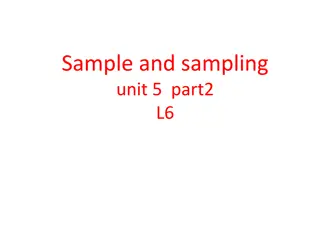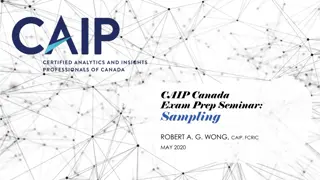Sampling Methods in Social Research
Sampling in social research involves selecting a subset of a population to make inferences about the whole. It helps in saving time and money, ensures accuracy in measurements, and allows estimation of population characteristics. The key principles of sampling include systematic selection, clear def
1 views • 19 slides
Sampling Methods in Statistical Analysis
Sampling is a crucial process in statistical analysis where observations are taken from a larger population. Different sampling techniques are used based on the analysis being performed. Sampling methods help in studying populations when studying the entire population is not feasible. There are two
4 views • 8 slides
Non-Probability Sampling Methods
Non-probability sampling methods involve selecting samples based on subjective judgment rather than random selection. Types include convenience sampling, quota sampling, judgmental (purposive) sampling, and snowball sampling. Convenience sampling picks easily available samples, quota sampling select
5 views • 7 slides
Sampling Methods and Errors in Research
Sampling is crucial in research to draw conclusions about a population. Various methods like simple random sampling, stratified sampling, and systematic sampling help in selecting representative samples. Sampling error arises due to differences between sample and population values, while bias leads
9 views • 12 slides
Probability: Experimental and Theoretical Concepts
Probability is the measure of the likelihood of an event happening, with experimental and theoretical probability being key concepts. Experimental probability involves determining probabilities through experience or experiments, while theoretical probability can be calculated without prior experienc
7 views • 23 slides
Biases in Sampling Methods
Statistical studies rely on samples to draw conclusions about populations, but the method of sampling can introduce biases. This text discusses convenience sampling, voluntary response sampling, random sampling, and the implications of biased sampling methods on study results. It highlights how bias
2 views • 12 slides
Lead Dust Wipe Sampling Techniques and Guidelines
This resource provides valuable information on lead dust wipe sampling techniques for Lead Dust Sampling Technicians. It covers the objectives, measuring lead dust, sampling strategy, sampling locations based on EPA RRP Rule, and HUD clearance regulations. Techniques for taking dust wipe samples, id
6 views • 41 slides
Comprehensive Guidelines for Meth Residue Sampling by Local Health Departments
This detailed guide outlines the procedures and protocols for meth residue sampling conducted by local health departments. It covers the reasons for sampling, the importance of qualified inspectors, testing methodologies, sampling kits assembly, and more. Key points include when and why sampling is
5 views • 19 slides
Sampling in Social Research Methods
Sampling in social research involves selecting a portion of a population to draw conclusions about the entire group. It helps save time, money, and allows for accurate measurements. The key principles of sampling include systematic selection, clear definition of sample units, independence of units,
4 views • 19 slides
Non-Probability Sampling Methods
Non-probability sampling involves selecting samples based on subjective judgment rather than random selection, leading to a lack of equal chances for all population members to participate. Various types include convenience sampling, quota sampling, judgmental sampling, and snowball sampling. Conveni
4 views • 7 slides
MCMC Algorithms and Gibbs Sampling in Markov Chain Monte Carlo Simulations
Markov Chain Monte Carlo (MCMC) algorithms play a crucial role in generating sequences of states for various applications. One popular MCMC method, Gibbs Sampling, is particularly useful for Bayesian networks, allowing the random sampling of variables based on probability distributions. This process
1 views • 7 slides
Approximate Inference in Bayes Nets: Random vs. Rejection Sampling
Approximate inference methods in Bayes nets, such as random and rejection sampling, utilize Monte Carlo algorithms for stochastic sampling to estimate complex probabilities. Random sampling involves sampling in topological order, while rejection sampling generates samples from hard-to-sample distrib
3 views • 9 slides
Introduction to Probability: Key Concepts and Definitions
Explore the fundamental concepts of probability including basic probability, conditional probability, Bayes Theorem, independence, sample space, events, counting, and the definition of probability. Learn about the significance of sample space, event subsets, and how probability laws encode knowledge
6 views • 31 slides
Non-Probability Sampling Methods
Non-probability sampling involves selecting samples based on subjective judgement rather than random selection. This method may not give all population members an equal chance to participate. Types include convenience sampling, quota sampling, judgemental sampling, and snowball sampling.
2 views • 7 slides
Sampling Methods in Research
Explore key concepts in sampling such as probability and non-probability methods, sampling error, representativeness, and types of biases. Learn about the importance of sampling in research, theoretical variables, conceptualization, and operationalization. Evaluate different types of sampling proces
8 views • 20 slides
Non-Probability Sampling Techniques in Nursing Research
Non-probability sampling in nursing research involves selecting samples subjectively rather than randomly. This sampling method carries a higher risk of bias and limits statistical inference about the entire population. Five main types include convenience, purposive, quota, snowball, and voluntary r
7 views • 30 slides
Sampling: Importance, Process, and Errors Explained
This content delves into the world of sampling, exploring why sampling is crucial, the sampling process involving defining populations and calculating sample sizes, and the distinction between non-sampling and sampling errors. It covers the significance of representative samples, common errors in sa
3 views • 15 slides
How Non-Ignorable is the Selection Bias in Non-Probability Samples?
Big Data often derive from non-probability samples, necessitating model-based approaches for inference. Tools to gauge non-ignorable selection bias in descriptive estimates from such samples are lacking. This work aims to address this gap by developing new measures. Building on previous work, the st
2 views • 27 slides
SAMPLING
Non-probability sampling methods like Quota Sampling, Judgemental Sampling, Systematic Sampling, and others offer various ways to select samples without considering probabilities. Learn about these methods and the differences between them to make informed decisions in your research studies.
24 views • 7 slides
Sampling Design in Research Methodology
A sampling design is crucial in research, determining how items are selected for a sample. Learn about characteristics, types, and examples of probability and non-probability sampling designs, including complex random sampling methods.
1 views • 8 slides
Sampling and Surveys: Understanding Population and Sample
In statistics, understanding the population and sample is crucial. Learn about different sampling methods, such as voluntary response and convenience sampling, and how they can introduce bias. Explore techniques like simple random sampling, stratified random sampling, and cluster sampling. Discover
4 views • 54 slides
Overview of Sampling Methods in Markov Chain Monte Carlo
This content covers various sampling methods in Markov Chain Monte Carlo including Rejection Sampling, Importance Sampling, and MCMC Sampling. It delves into representing distributions, drawbacks of Importance Sampling, and the motivation behind Markov Chain Monte Carlo Sampling. The illustrations p
0 views • 25 slides
Sampling Technique For Quantitative Data Presentation
This presentation focuses on sampling techniques for quantitative data collection in research studies. It covers concepts such as population, sample, sampling frame, types of sampling, and non-probability sampling methods. Dr. Aniket Shukla presents the importance of rigorous sampling plans to avoid
5 views • 17 slides
Fundamental Sampling Distributions and Random Sampling in Statistical Analysis
In statistical analysis, understanding fundamental sampling distributions and random sampling is crucial for making accurate inferences about populations. Sampling involves selecting a subset from a population to draw conclusions when observing the entire population is impractical. Random sampling h
2 views • 23 slides
Digital vs Analog Signal Conversion: Sampling, Quantizing, Coding
Discover the process of converting analog signals to digital using techniques like sampling, quantizing, and coding. Learn how sampling ensures accurate representation of analog signals in the digital realm, adhering to the sampling theorem for optimal signal reconstruction. Explore various sampling
1 views • 26 slides
Industrial Engineering Sampling Methods Overview
Learn about different sampling methods used in industrial engineering, including probability sampling (such as simple random sampling, stratified sampling, cluster sampling) and non-probability sampling (like volunteer and judgmental sampling). Understand the principles behind simple random sampling
5 views • 17 slides
Sampling Techniques for Quantitative Data in Health Research
This presentation discusses sampling techniques for quantitative data in health research, covering topics such as sample representativeness, sample frame, and types of sampling methods. It explains the importance of having a rigorous sampling plan to avoid biased estimates in research studies. The d
2 views • 17 slides
Sampling Methods for Population Studies
Learn about the challenges of studying entire populations and how sampling methods such as random and non-random sampling help generalize findings effectively. Explore probability and non-probability sampling techniques, including simple random sampling and systematic random sampling.
4 views • 13 slides
Sampling Methods in Statistics and Research
Learn about the different types of sampling methods in statistics and research, including purposive sampling, random sampling, stratified sampling, and more. Explore how sampling techniques are used to estimate characteristics of a population, with examples and explanations provided.
4 views • 11 slides
Sampling Methods in Research
Explore the importance of sampling in research, from drawing individual cases to studying populations efficiently. Learn about probability and non-probability sampling methods, sampling frames, and target populations. Discover how sampling helps researchers gather valuable insights while saving time
0 views • 37 slides
Sampling Methods for Research Studies
Discover the importance of sampling in research studies, including the characteristics of a good sample and the types of sampling methods like probability and non-probability sampling. Explore simple random sampling and its execution through methods like the lottery method and the use of random numb
1 views • 21 slides
Sampling Methods in Statistical Analysis
Sampling is a crucial process in statistical analysis where observations are taken from a larger population to draw valid conclusions. Understanding the population, sample, and sampling frame is essential in research to ensure representativeness and validity of results. Defining the target populatio
0 views • 9 slides
Understanding Sampling Techniques in Research Studies
Learn about different types of sampling methods including non-probability and probability sampling techniques such as simple random sample, systematic random sample, stratified random sampling, and cluster sampling. Explore why sampling is crucial in research, and how it helps in saving time and cos
0 views • 8 slides
Sampling Methods in Statistics and Probability
Explore the importance of sampling methods in statistical studies, focusing on convenience sampling, voluntary response sampling, and random sampling. Understand how each method can lead to bias and learn how random sampling helps avoid bias in collecting data to make accurate conclusions about popu
1 views • 8 slides
Understanding Sampling Methods in Research Methodology for M.Com 3rd Semester
Explore the significance of sampling methods in research methodology for M.Com 3rd semester. Learn about different sampling techniques, distinguish between probability and non-probability sampling, and understand the advantages and disadvantages of each method. Discover the importance of sampling in
3 views • 53 slides
Efficient Sampling Methods in Statistics
Explore various sampling methods in statistics like simple random sampling, systematic sampling, probability vs. non-probability sampling, and techniques to determine sample size using Cochran's and Yamani's formulas. Learn how to implement sampling in R for data analysis.
0 views • 21 slides
Methods and Formulas for Sampling in Statistics
Explore various sampling methods, formulas, and techniques used in statistics, including descriptive statistics, probability sampling, non-probability sampling, sample size calculations, and how to obtain samples in R programming. Learn about Cochran's rule and Cochran's formula for determining samp
2 views • 27 slides
Understanding Sampling Methods and Biases in Statistics
Learn about representative populations, different types of sampling biases, and various sampling methods like judgmental sampling, voluntary sampling, and stratified random sampling. Discover how biases can impact the accuracy of research outcomes and understand the importance of selecting samples i
1 views • 17 slides
Understanding Probability Sampling Methods in Research
Learn about simple random sampling and systematic random sampling as two common probability sampling methods used in research. Explore the characteristics, advantages, and limitations of each method to make informed sampling decisions in your research projects.
2 views • 17 slides
Understanding Non-Probability Sampling Methods
Explore the world of non-probability sampling techniques, including convenience sampling, quota sampling, judgemental sampling, and snowball sampling. Learn how researchers select samples based on subjective judgement rather than random selection, impacting data collection and analysis.
1 views • 7 slides







































